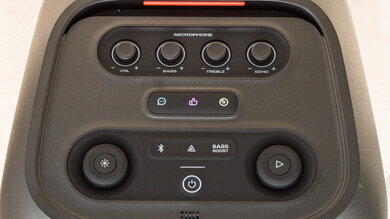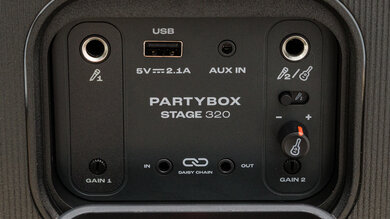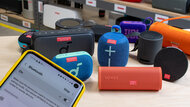The JBL PartyBox Stage 320 is a portable speaker that lets you wheel in a party-ready sound system for any occasion. It comes equipped with the familiar RGB lighting framing its drivers, dedicated mic and guitar inputs, and an IPX4 rating that makes it (mostly) party foolproof. Plus, its purported 18 hours of battery life and swappable battery pack design should have you partying through the day and into the night. There are options to connect to older PartyBox speakers and other Auracast-compatible speakers, too, which will be a welcome bonus for users who already own a JBL speaker.
Our Verdict
The JBL PartyBox Stage 320 is very good for music. It features a balanced sound with ample low-end on tap, which can help the kick drums and basslines of electronic music really shine. It has a balanced mid-range, too, which ensures vocals and lead instruments sound clear and detailed. Plus, you can always tune the sound to your liking via the graphic EQ and presets. While it can't get as loud as some of its larger PartyBox siblings, it's still loud enough to fill larger rooms with sound. There will be some compression in the bass range as you crank the beats, though. Its dual tweeter configuration means it's capable of playing back stereo content. Just be mindful that its front-facing design doesn't allow for the best directivity.
-
23 hours of continuous battery life.
-
Balanced default sound with plenty of low-end.
-
Gets loud.
-
Graphic EQ and presets in the companion app.
-
Directivity isn't the best.
-
Some compression in the bass range at max volume.
The JBL PartyBox Stage 320 is okay for videos and movies. Its default frequency response has plenty of low-end to inject excitement into action sequences and energetic soundtracks, and the balanced mid-range ensures that dialogue comes through clearly. It also gets plenty loud to soundtrack larger watch parties, though you'll want to switch off the potentially distracting RGB lights. Despite its capability of playing back stereo content, with some separation between left and right channels, its directivity isn't the best, so you'll need to ensure your audience is seated in line with the drivers to facilitate consistent audio reproduction. While latency with iOS and Android devices isn't the lowest, it should still make for a relatively lag-free experience. Different apps and devices compensate for latency differently, though.
-
Balanced default sound with plenty of low-end.
-
Gets loud.
-
Directivity isn't the best.
-
Some compression in the bass range at max volume.
The JBL PartyBox Stage 320 is good for podcasts. It's capable of rendering mid-range content, like your favorite podcast host's voice, in a detailed and clear way. Plus, it can get loud enough that audio won't get lost if you turn a fan on as you cook with a podcast on. That said, its directivity isn't the best, so audio sounds clearer from some angles over others. While you can always retract its carrying handle and wheel it to another room, you'll want to leave its bulky frame parked in one place wherever possible.
-
Balanced default sound with plenty of low-end.
-
Gets loud.
-
Bulky and heavy, even with the wheels and carrying handle.
-
Directivity isn't the best.
The JBL PartyBox Stage 320 doesn't have a mic or any integrated features that allow it to be used with a voice assistant.
The JBL PartyBox Stage 320 is very good for outdoor use. It's decently well-built and will survive spilled drinks and light showers alike, thanks to its IPX4 rating. Just don't dunk it in a pool and expect its heavy frame to float (or for it to still work). Its 23 hours of battery life means it can soundtrack even the longest dance parties, and it has the volume to project in outdoor settings, too. There will be some compression in the bass range, though, and its middling directivity means that not every partygoer will experience consistent audio reproduction.
-
23 hours of continuous battery life.
-
Balanced default sound with plenty of low-end.
-
Gets loud.
-
Mic and guitar inputs, with independent gain controls.
-
Bulky and heavy, even with the wheels and carrying handle.
-
Directivity isn't the best.
-
Some compression in the bass range at max volume.
- 7.9 Music
- 6.8 Videos/Movies
- 7.6 Podcasts
- 3.1 Voice Assistant
- 7.9 Outdoors
Changelog
-
Updated Jul 16, 2025:
We added a reference to the JBL PartyBox Encore Essential 2 in the Portability box.
-
Updated May 27, 2025:
Based on user feedback, we retested this speaker's Max SPL but achieved the same measurement. As a result, our test results have remained the same.
-
Updated May 13, 2025:
We've updated the text in the Frequency Response Accuracy box to clarify that this speaker struggles to reproduce mid-bass frequencies, due to its tuning.
-
Updated Nov 27, 2024:
We've updated results in Dynamics based on a retest, which has resulted in minor text changes throughout the review and product comparisons.
- Updated Oct 22, 2024: Review published.
Check Price
Differences Between Sizes And Variants
The JBL PartyBox Stage 320 comes in two color variants: 'Black' and 'White,' and here's a picture of its label. If you encounter another variant of this speaker, let us know in the comments, and we'll update our review.
Compared To Other Speakers
The JBL PartyBox Stage 320 is positioned in the middle of JBL's popular PartyBox line of portable speakers, both in terms of price and power. While it's not quite as portable as the JBL PartyBox On-The-Go (which is light enough to be carried around with a shoulder strap), it boasts the same ground-shaking volume outputted by the JBL PartyBox 710 (without the considerable heft). Users who want a speaker with even more bass on tap can check out the Sony ULT FIELD 7, which has two additional levels of 'ULT' bass. It also comes with an IP67 rating, making it a more durable choice than the mostly IPX4-rated PartyBox line.
If you're looking for more options, check out the best Bluetooth speakers for bass, the best JBL speakers, and the best Bluetooth speakers.
There's not much to differentiate between the JBL PartyBox Stage 320 and the JBL PartyBox 310. Both are large, bulky speakers that rely on their wheels and carry handle for portability. They're also both equipped with RGB light shows, mic and guitar inputs and stereo playback capabilities. The main difference is in bass and dynamics performance. The PartyBox 310 produces more punch by default, and also compresses a bit less at high volumes. There are some slight differences when it comes to frequency response, too. The Stage 320 features a more balanced response overall, compared to the 310's warmer, boomier sound, which some may like but others may find dull.
The JBL PartyBox Club 120 is a solid, more portable alternative to the JBL PartyBox Stage 320. Despite their differences in size and weight, they perform very similarly when it comes to frequency response and dynamics, and they're capable of achieving similar levels of bass. The Stage 320 is capable of getting louder though. Both speakers have a similar build quality, with IPX4 ratings, and they even both feature mic/guitar inputs for added karaoke/busking functionality. The key differences are in directivity, where the Club 120 offers more consistent audio reproduction from different angles, and battery life, where the Stage 320 offers 13 hours more juice per charge.
The JBL PartyBox Stage 320 is an optionally battery or A/C-powered speaker that weighs nearly half of the larger, Sony ULT TOWER 9AC. Its frequency response is more balanced, but it doesn't have as much low-end as the Sony. However, it compresses less at max volume, and despite its smaller size, it still gets very loud. Its controls are straightforward and focus on audio playback, while the Sony includes direct controls of the lights. Both include mic and guitar inputs and similar Bluetooth and wired connectivity, although the JBL has a wired line out, which is handy for adding any speaker with a line-in, and the Sony includes Optical input for connecting a TV or projector. On the other hand, if you're into bassy tuning, the Sony is the way to go. Like the JBL, it gets loud and it's quite bassy. That said, you need a power source nearby to use it.
The JBL PartyBox Stage 320 and the Ultimate Ears HYPERBOOM are both solid options for parties, with slightly different strengths. The Ultimate Ears is quite a bit more portable, and its design allows for better directivity. It has much lower latency with iOS and Android devices, too, and though it can't reach the same top volume as the JBL, it compresses considerably less. That said, the JBL has a more balanced default frequency response and comes with guitar and mic inputs for extra karaoke fun.
The Sony ULT FIELD 7 offers some key advantages over the JBL PartyBox Stage 320 when it comes to build quality and frequency response. The Sony's IP67 rating makes it a more durable, all-weather alternative to the JBL, and its switchable levels of bass via the 'ULT' button ensure there's plenty of low-end oomph available to call upon. It's also quite a bit more portable and can be carried around over your shoulder using its carrying strap. That said, the JBL boasts a much longer battery life, less compression at max volume (though both speakers have similar max volumes), and slightly better directivity.
The JBL PartyBox Stage 320 is a better speaker than the ION Tailgater Tough. It has a more balanced frequency response overall with greater extension in both the bass and treble ranges, so it's better suited for listening to a variety of music genres. The JBL also has a better soundstage with less directivity, so music sounds more consistent from various angles, and it can play audio in stereo without downmixing to mono, unlike the ION. It can get louder, too, albeit with some loss of clarity as you crank up the volume. The ION, on the other hand, is more portable, even when considering the JBL's wheels and collapsible handle.
Test Results
The JBL PartyBox Stage 320 looks pretty similar to many of the other speakers in JBL's PartyBox line, with the same LED ring lights on the drivers and a collapsible handle to more easily transport its wheeled frame. Unlike the JBL PartyBox 310, this version can only be placed vertically. It comes in 'Black' and 'White' variants.
This speaker isn't very portable. While it comes with wheels and a collapsible carrying handle, its heavy and bulky frame means that it's still not a great portable option. While it can technically be carried in one hand, it requires a great deal of strength to do so. If you're interested in a more portable PA-style speaker, consider the JBL PartyBox Encore Essential 2.
This speaker has a decent build quality. Its frame is made of tough, durable plastic, with a metal grille covering the drivers at the front. A small groove on the top panel can act as a phone holder, though we don't recommend putting anything here as you can easily break your device by applying force in the wrong direction. The speaker is rated IPX4, meaning it's protected against splashes of water, and there are sealable covers for the various inputs to help keep stray substances out. You'll find rubber feet on the bottom to help with stability, as well as built-in wheels that can help you cart it away. Additionally, there's a removable cover on the bottom of the speaker that can be used to mount the speaker to a stand for better projection.
This speaker's control scheme is great, meaning there's not much of a learning curve when it comes to using it. Most of the controls are located on the top panel, with additional controls for input gain found next to their respective inputs on the back panel. All the buttons on the top panel are clicky and easy to press, with secondary functions that correspond well to their primary functions. There's visual feedback from LEDs that indicate when Bluetooth pairing is in progress, as well as visual indicators for volume level, battery life, and Bass Boost status.
The JBL PartyBox Stage 320 has a great default frequency response accuracy. With the Bass Boost set to 'Deep' and with the 'JBL Signature EQ,' it produces a balanced sound, with plenty of rumble in the low-end that accentuates low basslines and kicks in electronic music. That said, there's some under-emphasis in the mid-bass range that can affect the presence of bass guitars: a byproduct of the more sub-bass-focused tuning. The mid-range is more balanced than the JBL PartyBox 310, too, resulting in vocals and lead instruments that have plenty of clarity, even in dense mixes. There's a bit of underemphasis in the treble range, though, which can take some of the airiness away from breathy vocals.
This speaker also comes with an 'AI Sound Boost' feature that the manufacturer claims analyzes the incoming audio signal in real-time using an AI algorithm to predict how this will affect the drivers. We subjectively found that this feature improved the tightness of the bass range.
The soundstage performance is decent. This speaker's driver configuration means that it has a pair of stereo tweeters and two mono subwoofers. Given most sound reproduction stems from the large tweeters, it's able to playback stereo content without downmixing to mono. Its directivity isn't the best though, so audio won't sound consistent across every listening angle around the speaker.
The JBL PartyBox Stage 320 has a great dynamics performance. It can get loud enough to fill a larger-sized room with sound, though there is some compression in the bass range as you crank the volume up.
This speaker has an incredible battery performance, especially considering its size. The manufacturer advertises up to 18 hours of playtime, but we were able to achieve over 23 hours during testing. As this speaker features a swappable battery pack, you can even purchase another JBL Battery 400 to double the battery life easily. There's also a power conservation feature that switches the speaker to standby mode after 20 minutes without audio input.
The JBL PartyBox app gives you lots of control over basic and more advanced parameters, as you can see from our app video. You can alter the sound via a graphic EQ and presets, adjust the RGB lights, or change any of the top panel controls without having to be physically near the speaker. You can also initiate True Wireless Stereo Pairing or Party mode with another compatible speaker and adjust the effects on the mic input. There are even some novelty DJ effects (mostly sound effects like airhorns and vinyl scratches) available via the Effect Lab. This PartyBox iteration also allows you to connect to older PartyBox speakers or other AuraCast-compatible JBL speakers.
This speaker has a few different wired inputs available for various uses. There's a standard AUX in/out for connecting or chaining devices via an analog connection. There's also a mic input and a guitar input, each with its own dedicated physical gain controls.
The JBL PartyBox Stage 320 has great Bluetooth connectivity. Support for multi-device pairing is included, so you can pair up to two devices. Latency with both Android and iOS devices falls within good limits, too, so you won't experience much in the way of lag between your audio and video if you use the speaker to soundtrack a movie. Different apps and devices compensate for latency differently, though. That said, there's only support for the SBC codec, with no option to connect via high-resolution codecs like LDAC.
Comments
JBL PartyBox Stage 320: Main Discussion
Let us know why you want us to review the product here, or encourage others to vote for this product.
Update: We added a reference to the JBL PartyBox Encore Essential 2 in the Portability box.
- 21010
In terms of sound quality, I feel like its worth mentioning that this speaker has trouble in the high-bass range (about 75-120hz). I guess this is due to the cabinet being tuned for sub bass frequencies (about 35-40hz). Its quite noticeable if you listen to this alongside a more traditional full-range 2-way speaker that isn’t designed to produce sub-bass.
Hi eiglow,
That’s good feedback. We will be updating our Frequency Response Accuracy Box.
- 21010
In terms of sound quality, I feel like its worth mentioning that this speaker has trouble in the high-bass range (about 75-120hz). I guess this is due to the cabinet being tuned for sub bass frequencies (about 35-40hz). Its quite noticeable if you listen to this alongside a more traditional full-range 2-way speaker that isn’t designed to produce sub-bass.
- 32120
Apologies for being a pain, but the 310 was tested on both battery and mains power. Does the 320 gain a similar volume boost when plugged in and does compression change at all?
Hello sbanga,
Unfortunately, it does not appear that the 320 gains the same treatment. Regardless if running off of battery power or AC, the speaker will only output a maximum of 105-107 dB SPL. Performance with compression also remains the same.


































